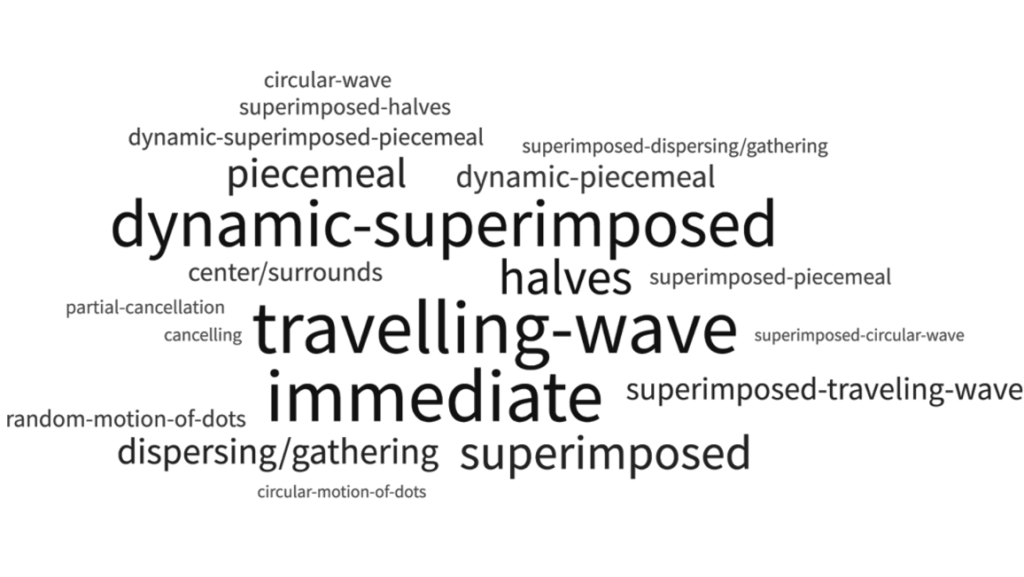Investigating the perceptual variety of transitions in binocular rivalry
Context
Part of my PhD research in the Visual Neuroscience Lab, University of Graz, Austria
- Supervisor: Assoc. Prof. Dr. Natalia Zaretskaya
- Period: 09/2020 – Present
Binocular rivalry occurs when two eyes are presented with two different images that cannot be fused into each other as a uniform perception. As a result, the subject has a perception alternating between the dominant image of either of the presentations with a transition phase.

Research Questions
- How many different appearances can observers perceive during perceptual transitions in binocular rivalry?
- Are the transition appearances consistent over time?
- Does the observers’ age affect the transition appearance?
- How does the contrast of stimuli influence the transition apperance?
- How does the locus of attention affect the transition appearance?
Objective: Understand the dynamics of conscious visual perception using behavioral data.
Experiment 1: Qualitative descriptions of transitions & Age effect
I presented different visual stimuli to the participants. After the stimulus presentation, they described what they perceived during the perceptual transitions verbally and with a simple sketch. Then, my colleagues and I categorized these transition descriptions.
125 participants (18-65 years)
Binocular rivalry (BR) paradigm
Stimulus types:
- gratings with orientation of ± 45 degree
- images of house and face
- moving dots
- grating and image
- moving dots and image
- moving dots and grating
Task: Press a button to report exclusive percept
Experiment 2: Contrast & Attention effect on transition types
Again, the participant were presented by different visual stimuli. They pressed one of four buttons to report which type of transition they were perceiving. I manipulated the contrast of stimuli and attention of the participant during the experiments. Then, I analyzed the effect of my manipulations on the duration and relative frequency of transition types.
79 participants (18-40 years)
Binocular rivalry (BR) paradigm
Stimulus types:
- gratings with orientation of ± 45 degree
- images of house and face
- moving dots
Task: Press a button to report transition type
Methods & Results
Analysis of behavioral data
→ Preprocessing (cleaning irrelavant keys, removing outliers)
→ Linear mixed model (LMM) for BR parameters
→ Cochran's Q test (categorical ANOVA)
→ Visualization of transition reports
Findings:
- 20 categories of transition appearance
- Effect of stimulus type
- Consistency in time
- Individual difference
- Decline of probability with age
- Similar quantitative but different qualitative effect of contrast & attention
Tools & Libraries
- R: stats, nlme, lme4, emmeans, ggplot2
- Psychtoolbox for stimulus presentation and behavioral recording
- R Markdown for reproducible analysis
Outcome & Impact
This research project focuses on the phenomenology and dynamics of conscious visual perception. Through a series of psychophysical studies on binocular rivalry, I explored how perceptual transitions emerge, how they are experienced subjectively, and how they are influenced by factors such as attention and contrast.
This line of work contributes to a growing shift in consciousness research—from merely correlating perception with physical stimuli toward examining how experience itself unfolds over time. By quantifying subtle aspects of subjective transitions, my studies help to characterize conscious perception as a continuous, temporally structured process rather than a series of discrete states.
Together, my publication in Neuroscience of Consciousness and my preprint in PsyArXiv highlight the value of combining rigorous behavioral experimentation with careful phenomenological analysis. They advance an empirical approach to consciousness that respects both the measurable and the experiential dimensions of perception.
Publications
PsyArXiv
Yilmaz, C., Maitz, K., Gerschütz, M., Grassegger, W., Ischebeck, A., Bartels, A., and Zaretskaya, N. (2025). Differential effects of attention and contrast on transition appearance during binocular rivalry. PsyArXiv preprint. DOI: 10.31234/osf.io/64ja9_v2
Neuroscience of Consciousness
Yilmaz, C., Pabel, L., Kerschenbauer, E., Ischebeck, A. Sipatchin, A., Bartels, A. and Zaretskaya, N. (2025). The complexity of human subjective experience during binocular rivalry. Neuroscience of Consciousness. DOI: 10.1093/nc/niaf004
Public talk
3 Minute Thesis Competition, 15.03.2024, Graz, Austria. Video
Conference talks
53rd DGPs Congress/15th ÖGP Conference, 16.09.2024, Vienna, Austria. https://dgps2024.univie.ac.at/home-news/
Trieste Symposium on Perception and Cognition, 27.10.2023, Trieste, Italy. https://sites.units.it//bernardis/symposium2023.html
Poster presentation
European Conference on Visual Perception (ECVP), 30.08.2023, Paphos, Cyprus. Perception
Reproducible pipeline
Fully documented analysis notebooks available on GitHub & OSF
Yilmaz C, and Zaretskaya N. Top-down and bottom-up effects on the subjective experience during binocular rivalry [Dataset]. OSF, 2024. DOI: 10.17605/OSF.IO/FQYXB
Yilmaz C, and Zaretskaya N. The Complexity of Subjective Experience during Binocular Rivalry [Dataset]. OSF, 2024. DOI: 10.17605/OSF.IO/N6DQF
Keywords: cognitive neuroscience, visual perception, binocular rivalry, psychophysics, data science